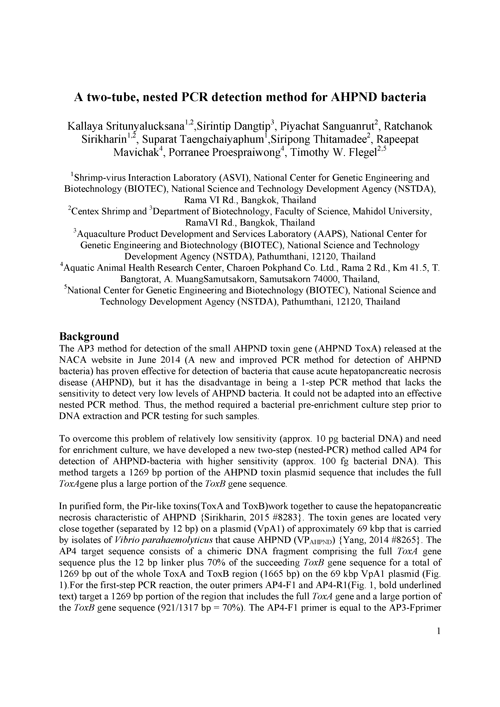A two-tube, nested PCR detection method for AHPND bacteria
20 February 2015 | Sritunyalucksana, K., Dangtip, S., Sanguanrut, P., Sirikharin, R., Taengchaiyaphum, S., Thitamadee, S., Mavichak, R., Proespraiwong, P., Flegel, T.W. | 1558 Downloads | .pdf | 133.96 KB | Health and Biosecurity, Shrimp, Thailand
A new method for the detection of AHPND-bacteria (AP4) has been published and is available for download. The advantage of the AP4 method over the previously published AP3 method is that it has 100 times higher sensitivity. Because of its higher sensitivity, the bacterial culture enrichment step needed when using the AP3 with low levels of AHPND bacteria may be omitted. However, the AP4 method should not be considered as a replacement for the AP3 method but simply as an alternative choice for the users.
The AP4 method was tested with the same 104 bacterial isolates which were used for validating the AP3 detection method, and the results were identical, ie, 100% specificity and sensitivity with the 104 isolates at 100x lower template levels.
As with the previous announcements in this series, the AP4 method is provided for use in the detection of AHPND bacteria. A positive control plasmid for the AP4. Methods for detecting AHPND bacteria. Dr. Kallaya Sritunyalucksana (email kallaya 'at' biotec.or.th). To join the mailing list, please visit the AHPND Detection Google Group .
The AP4 PCR method was developed by Thailand at Centex Shrimp, the Shrimp-Virus Interaction Laboratory, BIOTEC and Aquatic Animal Health Research Center and Charoen Pokphand Co. Ltd. It was also supported by research funding from Thailand. The National Research Council of Thailand, the Thai Commission for Higher Education, Mahidol University, Faculty of Marine Technology at Burapha University, Science and Technology Development Agency, the Patani Shrimp Farmers Club, the Surathani Shrimp Farmers Club, the Thai Frozen Foods Association, the Charoen Pokphand Company, SyAqua Co. Ltd. And Thai Union Co. Ltd.
Copyright, all rights reserved.

